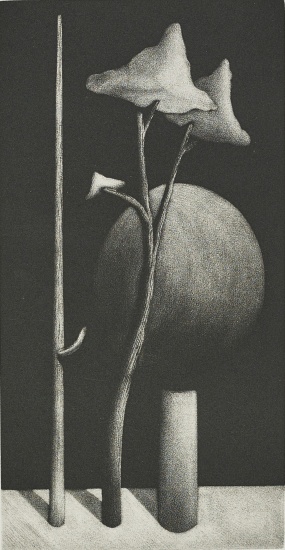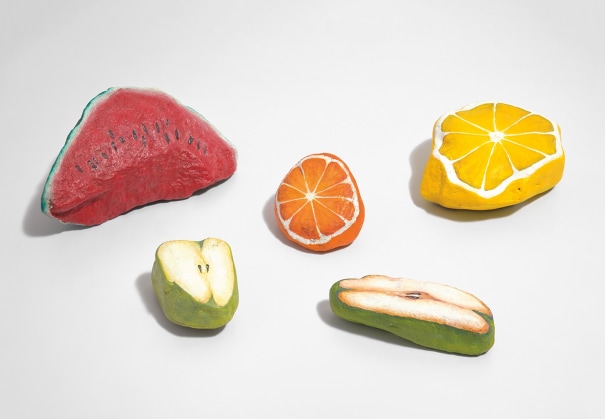Property from a Distinguished European Collection9Nicolas PartyRockssigned and dated 'Nicolas Party 2014' on the reverse pastel on canvas 150 x 150 cm (59 x 59 in.) Executed in 2014. Full CataloguingEstimate £400,000 - 600,000 Place Advance BidContact Specialist Kate Bryan Specialist, Head of Evening Sale +44 20 7318 4026 kbryan@phillips.com
'I don’t have much interest in what could be labelled as ‘reality’. I’m more interested in the signs, symbols and codes we’ve created for reality.' —Nicolas Party Nicolas Party’s colourful compositions are as inventive as they are familiar. Addressing longstanding themes of landscape painting, portraiture and still life, Party suffuses the old with the new, drenching the resulting compositions in luxurious, otherworldly hues. Rocks, executed in 2014, is a sumptuous example of the artist’s distinctive practice, gesturing specifically toward the genre of still life and devised on a monumental scale. The heir to canonical figures such as Jean-Baptiste-Siméon Chardin, Pieter Claesz, and Francisco de Zurbarán Party likewise exploits the art historical convention of still life painting as a means of investigating contemporaneous interests, namely the omnipresence of technology and computer-generated imagery in a post-internet era. Also alluding to the tranquil, focused compositions of Giorgio Morandi and Milton Avery whose distinctive portrayal of objects as single-coloured forms undeniably foreshadow those of Party, Rocks betrays an embracing of the genealogy of still life whilst incorporating the artist’s own visual particularities. Testament to its importance in Party’s oeuvre, Rocks was included in the artist’s monographic exhibition Nicolas Party. Pastel et nu, at the Centre culturel suisse in early 2015, as well as his solo show Nicolas Party: Boys and Pastel which took place at the Royal Botanic Garden Edinburgh later that same year. Not unlike Paul Gauguin’s uncompromising approach to colour – ‘Pure colour! Everything must be sacrificed to it’, the artist exclaimed – Party’s treatment of tonality posits his surrounding environments as only loose suggestions from which to devise his own idiosyncratic colouring. In Rocks, the eponymous elements lose their earthy hues and instead transform into vivid blocks of scarlet red, blood orange, and hot pink. Situated somewhere between fact and fiction, the composition thus epitomises Party’s assertion that ‘I don’t have much interest in what could be labelled as 'reality'. I’m more interested in the signs, symbols, and codes we’ve created for reality’.i Coalescing the art of the Old Masters with French modernism whilst firmly placing his creation in the context of our post-internet experience, Rocks encourages a closer look at the evolution of representation. As the Hammer Museum’s curator Ali Subotnick explained at the opening of Party’s first exhibition in Los Angeles, ‘Nicolas collapses the past with the present and future…he never gets stuck in a formulaic pattern’.ii Paul Gauguin Tropical Landscape, Martinique, 1887, oil on canvas, Staatsgalerie Moderner Kunst, Munich. Image: Bridegman Images. Nicolas Party In Conversation In an interview with Rita Vitorelli, Nicolas Party discussed naivety, the slowness of matter, and what’s special about the human hand. [In your work] we meet a lot of familiar acquaintances: David Hockney Morandi, Picasso, Matisse, Botero, Félix Vallotton Would you say that you’re sampling art history? I think that when you use mediums like painting and drawing, ones that have been practiced for so long, dialogue with other artists is very common. If you decide to paint an apple, you will have a dialogue with everybody who has painted an apple before, which is a lot of people. Looking at one painting through the lens of another is very natural. Everything we look at is compared to what we know. I think that’s how we value objects and ideas: by comparison. Instead of the word 'acquaintance' I would use 'dialogue'. It’s a nice idea that your painting could somehow have a dialogue with another one. Vallotton and I can’t have a conversation. But if you hang a Vallotton painting in the same room as one of my paintings, the two works will speak to each other. I don’t know if they will get along, that’s up to them. A lot of works by a younger generation of artists
Property from a Distinguished European Collection9Nicolas PartyRockssigned and dated 'Nicolas Party 2014' on the reverse pastel on canvas 150 x 150 cm (59 x 59 in.) Executed in 2014. Full CataloguingEstimate £400,000 - 600,000 Place Advance BidContact Specialist Kate Bryan Specialist, Head of Evening Sale +44 20 7318 4026 kbryan@phillips.com
'I don’t have much interest in what could be labelled as ‘reality’. I’m more interested in the signs, symbols and codes we’ve created for reality.' —Nicolas Party Nicolas Party’s colourful compositions are as inventive as they are familiar. Addressing longstanding themes of landscape painting, portraiture and still life, Party suffuses the old with the new, drenching the resulting compositions in luxurious, otherworldly hues. Rocks, executed in 2014, is a sumptuous example of the artist’s distinctive practice, gesturing specifically toward the genre of still life and devised on a monumental scale. The heir to canonical figures such as Jean-Baptiste-Siméon Chardin, Pieter Claesz, and Francisco de Zurbarán Party likewise exploits the art historical convention of still life painting as a means of investigating contemporaneous interests, namely the omnipresence of technology and computer-generated imagery in a post-internet era. Also alluding to the tranquil, focused compositions of Giorgio Morandi and Milton Avery whose distinctive portrayal of objects as single-coloured forms undeniably foreshadow those of Party, Rocks betrays an embracing of the genealogy of still life whilst incorporating the artist’s own visual particularities. Testament to its importance in Party’s oeuvre, Rocks was included in the artist’s monographic exhibition Nicolas Party. Pastel et nu, at the Centre culturel suisse in early 2015, as well as his solo show Nicolas Party: Boys and Pastel which took place at the Royal Botanic Garden Edinburgh later that same year. Not unlike Paul Gauguin’s uncompromising approach to colour – ‘Pure colour! Everything must be sacrificed to it’, the artist exclaimed – Party’s treatment of tonality posits his surrounding environments as only loose suggestions from which to devise his own idiosyncratic colouring. In Rocks, the eponymous elements lose their earthy hues and instead transform into vivid blocks of scarlet red, blood orange, and hot pink. Situated somewhere between fact and fiction, the composition thus epitomises Party’s assertion that ‘I don’t have much interest in what could be labelled as 'reality'. I’m more interested in the signs, symbols, and codes we’ve created for reality’.i Coalescing the art of the Old Masters with French modernism whilst firmly placing his creation in the context of our post-internet experience, Rocks encourages a closer look at the evolution of representation. As the Hammer Museum’s curator Ali Subotnick explained at the opening of Party’s first exhibition in Los Angeles, ‘Nicolas collapses the past with the present and future…he never gets stuck in a formulaic pattern’.ii Paul Gauguin Tropical Landscape, Martinique, 1887, oil on canvas, Staatsgalerie Moderner Kunst, Munich. Image: Bridegman Images. Nicolas Party In Conversation In an interview with Rita Vitorelli, Nicolas Party discussed naivety, the slowness of matter, and what’s special about the human hand. [In your work] we meet a lot of familiar acquaintances: David Hockney Morandi, Picasso, Matisse, Botero, Félix Vallotton Would you say that you’re sampling art history? I think that when you use mediums like painting and drawing, ones that have been practiced for so long, dialogue with other artists is very common. If you decide to paint an apple, you will have a dialogue with everybody who has painted an apple before, which is a lot of people. Looking at one painting through the lens of another is very natural. Everything we look at is compared to what we know. I think that’s how we value objects and ideas: by comparison. Instead of the word 'acquaintance' I would use 'dialogue'. It’s a nice idea that your painting could somehow have a dialogue with another one. Vallotton and I can’t have a conversation. But if you hang a Vallotton painting in the same room as one of my paintings, the two works will speak to each other. I don’t know if they will get along, that’s up to them. A lot of works by a younger generation of artists


.jpg)


.jpg)
.jpg)
.jpg)
.jpg)
.jpg)
.jpg)
.jpg)
.jpg)
.jpg)
.jpg)
Testen Sie LotSearch und seine Premium-Features 7 Tage - ohne Kosten!
Lassen Sie sich automatisch über neue Objekte in kommenden Auktionen benachrichtigen.
Suchauftrag anlegen